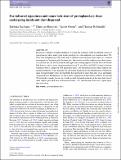Files in this item
Far-infrared signatures and inner hole sizes of protoplanetary discs undergoing inside-out dust dispersal
Item metadata
| dc.contributor.author | Ercolano, Barbara | |
| dc.contributor.author | Koepferl, Christine | |
| dc.contributor.author | Owen, James | |
| dc.contributor.author | Robitaille, Thomas | |
| dc.date.accessioned | 2016-02-19T16:40:09Z | |
| dc.date.available | 2016-02-19T16:40:09Z | |
| dc.date.issued | 2015-10-01 | |
| dc.identifier | 241104230 | |
| dc.identifier | 7d122ded-4cbf-4a7c-b90d-809fbcac3673 | |
| dc.identifier | 84940121792 | |
| dc.identifier.citation | Ercolano , B , Koepferl , C , Owen , J & Robitaille , T 2015 , ' Far-infrared signatures and inner hole sizes of protoplanetary discs undergoing inside-out dust dispersal ' , Monthly Notices of the Royal Astronomical Society , vol. 452 , no. 4 , pp. 3689-3695 . https://doi.org/10.1093/mnras/stv1528 | en |
| dc.identifier.issn | 0035-8711 | |
| dc.identifier.other | BibCode: 2015MNRAS.452.3689E | |
| dc.identifier.uri | https://hdl.handle.net/10023/8269 | |
| dc.description | JEO acknowledges support by NASA through Hubble Fellowship grant HST-HF2-51346.001-A awarded by the Space Telescope Science Institute, which is operated by the Association of Universities for Research in Astronomy, Inc., for NASA, under contract NAS 5-26555. | en |
| dc.description.abstract | By means of radiative transfer simulation, we study the evolution of the far-infrared colours of protoplanetary discs undergoing inside-out dispersal, often referred to as transition discs. We show that a brightening of the mid- and far-infrared emission from these objects is a natural consequence of the removal of the inner disc. Our results can fully explain recent observations of transition discs in the Chamaleon and Lupus star-forming regions from the Herschel Gould Belt Survey,which shows a higher median for the 70 μm (Herschel PACS 1) band of known transition objects compared with primordial discs. Our theoretical results hence support the suggestion that the 70 μm band may be a powerful diagnostic for the identification of transition discs from photometry data, provided that the inner hole is larger than tens of au, depending on spectral type. Furthermore, we show that a comparison of photometry in the K, 12 μm and 70 μm bands to model tracks can provide a rough, but quick estimate of the inner hole size of these objects, provided their inclination is below ˜85° and the inner hole size is again larger than tens of au. | |
| dc.format.extent | 7 | |
| dc.format.extent | 16727985 | |
| dc.language.iso | eng | |
| dc.relation.ispartof | Monthly Notices of the Royal Astronomical Society | en |
| dc.subject | Protoplanetary discs | en |
| dc.subject | QB Astronomy | en |
| dc.subject | QC Physics | en |
| dc.subject | NDAS | en |
| dc.subject.lcc | QB | en |
| dc.subject.lcc | QC | en |
| dc.title | Far-infrared signatures and inner hole sizes of protoplanetary discs undergoing inside-out dust dispersal | en |
| dc.type | Journal article | en |
| dc.contributor.sponsor | Science & Technology Facilities Council | en |
| dc.contributor.institution | University of St Andrews. School of Physics and Astronomy | en |
| dc.identifier.doi | 10.1093/mnras/stv1528 | |
| dc.description.status | Peer reviewed | en |
| dc.identifier.url | http://adsabs.harvard.edu/abs/2015MNRAS.452.3689E | en |
| dc.identifier.grantnumber | ST/M001296/1 | en |
This item appears in the following Collection(s)
Items in the St Andrews Research Repository are protected by copyright, with all rights reserved, unless otherwise indicated.

